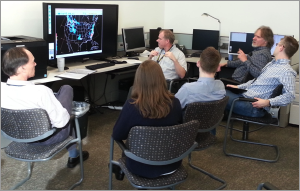The 2014 HMT-WPC Winter Weather Experiment
May 9, 2014
HMT at the Weather Prediction Center (HMT-WPC) recently concluded its fourth annual Winter Weather Experiment at the National Center for Weather and Climate Prediction in College Park, MD. Held over four weeks from January 21 – February 21, this year's experiment focused on emerging short range microphysics-based snowfall forecasting techniques, as well as extending winter weather forecasts as much as a week in advance.
A total of 23 on-site participants from the forecasting, research and numerical modeling communities were asked to use experimental and operational model data to issue a deterministic snowfall forecast for either the Day 1 (24 – 48 hr) or Day 2 (48 – 72 hr) period. The time frame of a 6-hr deterministic snowfall was chosen by the forecast team based on the period most critical to the overall evolution of the event. Subsequently, each afternoon participants created 24-hour probabilistic winter weather outlook forecasts for Days 4-7. Based on the National Weather Service’s goal of extending winter weather guidance beyond 72 hours, these forecasts identified the probability of receiving at least 0.10” precipitation (liquid equivalent) in the form of snow, sleet, or freezing rain. In addition to the experimental forecasts, participants also created a forecast discussion presentation and partook in the subjective evaluation of the experimental model guidance. For the first time, remote participation from 13 forecasters from various NWS forecast offices was facilitated.

Read the Final Report
One highlight of the experiment was the continued evaluation of the rime factor-modified snowfall, which uses information from the model’s physics scheme to adjust the snowfall totals. Featured in the North American Model (NAM) in the 2013 experiment, this year the rime factor was expanded and also included in the parallel version of the Short Range Ensemble Forecast System (SREF). Additionally, participants provided helpful feedback on the new Day 4-7 winter weather forecasts by evaluating the experimental guidance, and providing helpful suggestions about the product’s definition, display and overall usefulness. As a result, HMT-WPC will continue to work with the Environmental Modeling Center (EMC) on developing the rime factor, as well work to develop improved probabilistic winter weather guidance in support of WPC making the Day 4-7 forecasts experimental next winter.
The 2014 HMT-WPC Winter Weather Experiment provided a unique opportunity to bring the forecasting, research, and model development communities together to explore the challenges associated with winter weather forecasting. The experiment identified several ways to improve and highlighted the various next steps needed to develop and expand WPC's winter weather forecasts over the coming year.
Contact: Tom Workoff